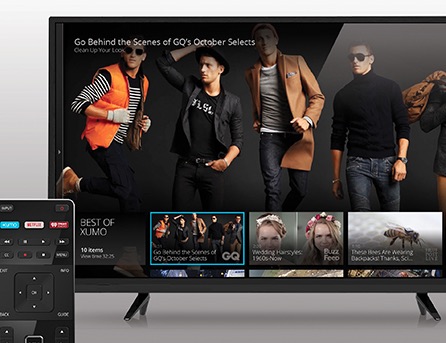Xumo Secures Smart TV Beachheads

As with Roku or any other streaming-media platform, standing out from a multitude of apps is a major challenge for over-the-top video players. It’s important to be part of the apps mix, but it’s equally difficult to get noticed, let alone get used frequently.
That’s one of the challenges that Xumo has taken on, with a platform that has a heavy initial focus on connected TV platforms from some major manufacturers, alongside emerging apps for mobile devices. The company also has a longer-range plan to help it and its content partners get on other TV-connected streaming platforms.
After working in relative stealth mode for about four years, Xumo launched last October on Panasonic TVs, with a debut on Vizio TVs shortly afterwards. It is also gearing up for launches on TVs from LG Electronics and Funai Electric, which makes and distributes TVs under the Sanyo, Philips and Magnavox brands in North America.
Xumo estimates that its OTT platform is currently available on 20 million devices in the U.S, and expects to increase that number throughout the year.
Xumo doesn’t develop content, but it offers more than 50 “channels” via partnerships with companies such as Condé Nast Entertainment, Bloomberg, Reuters, Time Inc., The Wall Street Journal, BuzzFeed, PopSugar, Mitú Network, Machinima, TYT Network and The Onion.
The Xumo platform kicked off with free, ad-supported fare. “They [our partners] feel very strongly, like I do, that there’s an expectation that there’s a certain amount of television that should be free,” Colin Petrie-Norris, Xumo’s CEO, said, noting that Xumo was born out of Viant, which runs an online ad business.
Xumo is also looking to launch subscription-based content this summer, “but at our core, free [content] is very important to us,” Petrie-Norris said.
The smarter way to stay on top of broadcasting and cable industry. Sign up below
While a typical TV ad load can run 20 minutes per hour, Xumo’s load is typically “well shy of half of that,” Petrie-Norris said.
Xumo hopes to stand apart using data and algorithms that help to match consumers with programs, underpinned with a smart ad platform.
Its other rationales are to ease the path to the big screen for digital brands, and to license content rather than offer it under a model that leans on digital embedding rules.
“We enter into contracts with each of our content partners with the explicit right to carry,” Petrie-Norris said. “It took a little longer to do it that way, but the content partners appreciate it because there’s a very explicit revenue benefit and also control and security that helps to protect against piracy.”
The approach also affords Xumo partners access to smart-TV platforms without having to code their own apps for the fragmented smart-TV sector. Xumo connects to those platforms via Media RSS feeds or application program interfaces (APIs).
Xumo also tries to help out with discovery. Its TV partnerships ensure that Xumo is natively integrated into a TV set’s operating system, rather than just being one app in a sea of them.
Xumo is also looking beyond smart TVs, as it has Android and iOS mobile apps now in the alpha phase. It’s also exploring integrations on other streaming media and gaming console platforms.
Those other platforms “are not our core focus, but important as a side focus,” Petrie-Norris said.
Early on, Irvine, Calif.-based Xumo is finding that partners that deliver fresh content on a daily basis get the most engagement and return viewership.
“News … has proven to be a big area for us,” Petrie-Norris said.
Xumo’s system is already ingesting 4K content, but not yet outputting it in that format.
The company will pursue 4K with more vigor after the market further matures, Petrie-Norris said.
“The ad rates aren’t there to make it worthwhile yet,” he said. “But will be a bigger part of all streaming services.”
